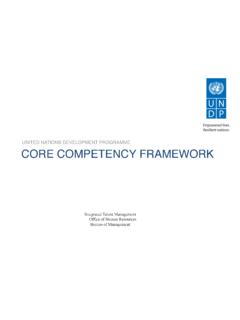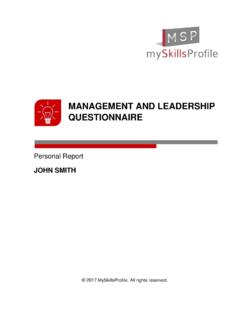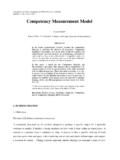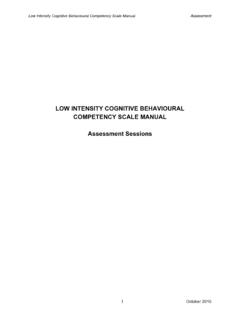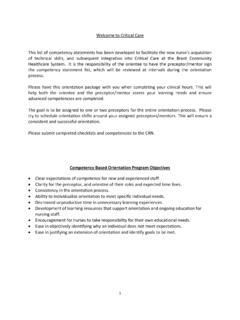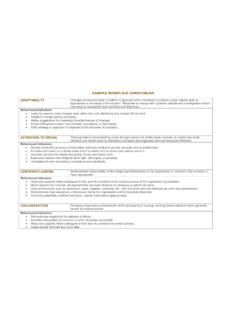Transcription of How to develop competency models - Centranum
1 How to develop competency models An in-depth guide Centranum Group 2019 2 Contents Brief Overview of competency models .. 3 What is a competency Model? .. 3 Why have a competency model? .. 3 competency Types & Primary Usage .. 4 Developing a competency model .. 6 Step 1 - A clear purpose .. 6 Step 2 - Put together a team .. 6 Step 3 First Considerations .. 7 Model Structure Options .. 7 Terminology .. 11 Step 4 Compile competency List & definitions .. 11 Step 5 develop competency standards .. 19 Core and Leadership Competencies .. 19 Occupational Competencies .. 20 Assign Degrees of Difficulty - Competence Levels .. 21 Step 6 Decide Scoring Rubric - Rating Scales .. 21 Values, Core and Leadership Competencies .. 21 Common mistakes with rating scales and scoring .. 22 Occupational Competencies .. 23 Validity .. 23 Validation .. 25 competency models are dynamic .. 26 3 Brief Overview of competency models What is a competency Model?
2 A competency is the ability to use a set of relevant knowledge, skills, and abilities to successfully perform critical work functions or tasks, in a defined work setting. A competency model (or competency framework) is a set of competencies a blueprint for success. It may apply to; all staff in the organization a level of leadership a job role a business function a professional discipline a particular job task Why have a competency model? The purpose of a competency model is three-fold. It communicates what is expected of staff, how they should do their job. It is used as a benchmark to ensure people have the skills they need for success. It is used to organise and provide access to individual development resources competency models are used across all people management practices including; Align workforce and strategy Shape culture Recruitment and selection, onboarding Performance management productivity improvement develop Capability Career development Talent pool development Succession and workforce planning Project staffing 4 They are also a tool to improve compliance and quality and reduce the risk of human error.
3 competency Types competency models differ by competency Type, as does their method of development. They fall into 3 main types Values Based Competencies Core & Leadership Competencies Occupational Competencies There are different approached to developing models for each type. competency Types & Primary Usage Type Communicate expectations Improve performance Ensure compliance Minimise risk QA develop capability Career, Staffing & Succession Certification Values based behaviours Core & Citizenship Leadership Occupational 5 Performance management Values based competencies Competencies that align with the organisational mission and purpose. For example, in healthcare Compassion is a common competency . For service organisations Customer Service is a key organisational competency . These competencies play a role in shaping behaviour because they are communicated as expectations and used as part of performance assessment Core & Citizenship (collaborative) Competencies These are competencies that outline expectations of how people will work both individually and collaboratively.
4 Examples of individual core competencies may include Decision Making, collaborative competencies almost always include Teamwork. As for values-based competencies, they play a role in shaping behaviour. Leadership competencies Sometimes core leadership competencies such as Performance Management and Integrity are included in performance appraisal. When this is the case, they signal expected leadership style and behaviours. Recruitment Competencies are observable on job behaviours. Therefore, when competencies are used in recruitment typically only the headings are used. (Unless the recruitment process includes task-based assessment where direct observation can be made.) Capability Development Leadership Competencies More extensive leadership competency models are used for development. Since different levels of leadership have different responsibilities competency models may differ by leadership tier or they may include a number of levels reflecting leadership seniority.
5 Occupational competencies Most organisations will have multiple occupational competency models . While it is possible to standardise the format and structure across the organisation, it is more flexible to allow each area to set up the models that best suit the way they assess and develop their staff. Of these there will be a subset of competencies used for certifications and compliance purposes. 6 Developing a competency model competency models depend on the competency type and purpose. There should be a competency model or framework for each set of competencies. One for the core values, another for core competencies, a leadership competency model and multiple competency models for job specific competencies. Step 1 - A clear purpose How the competency model is going to be used determines how it is developed. Essentially competency models may be used to; communicate expectations assess performance ensure compliance minimise risk develop capability award certification Step 2 - Put together a team In order to ensure validity of the model input and feedback is needed from those who will use the competencies.
6 For Values based competencies from strategic leadership down through the organisation. For Core Competencies again cross organization input and feedback is needed. For job or occupation specific competencies input from subject matter experts Usually there is a steering committee with input from staff and subject matter experts. The teams need to provide input and feedback on; The competency list with high level definition The hierarchy of the competencies if any Levels of competence/proficiency if required The statements that will represent the competency How the competency will be assessed 7 Step 3 First Considerations Model Structure Options You need to provide for 4 levels in competency frameworks to cover all possibilities. 8 Complexity of competency models varies Core and Core Leadership Competencies The structure of the competency model will depend on the way it is to be used. The purpose of the competency model is to provide information for decision-making by comparing people against the model.
7 How those comparisons are to be done is a key factor in deciding model structure. In performance reviews/appraisals or in developmental 360-degree feedback for observers complete a survey. Core and leadership competency models are theories of what comprises for example leadership . As with all theories your aim is to distil it to the most accurate and simple definition of leadership in the context of your organization and its operations. Theoretically the list of possibilities for your list is huge. You need to boil it down the fewest possible relevant competencies, subheadings and statements. For these kinds of competency models a list of maximum 6-8 competencies with no subheadings and a maximum of 4-6 statements/behaviours each is sufficient. Any more than this will overload observers so that responses are not properly considered. The structure will be competency + behaviours 9 Values based competencies The same structure as above -or just a competency with a description of behaviours and no separately rated behaviour list Multi-Level Leadership Competencies Leadership competency frameworks can be complex.
8 They may have competency headings and subheadings. They may have statements at different levels reflecting different leadership requirements according to seniority or leadership role type. Use this structure to assess a person against all the competence levels to determine which level they have achieved. Alternatively, the simpler format of competency plus statements can be used to make a competency set for each leadership level. Occupational Competencies For Occupational Competencies that will be assessed on the job the scope is quite different. Since there is a direct relationship to the job role the competency model is less theoretical, and more complex. The complexity is not an issue because the competencies are not assessed all at once as a snapshot, but as a continuing exercise or in subsections as an audit. Use job analysis of relevant positions to identify the key responsibilities, their relative importance, and the context in which they are carried out.
9 10 This analysis will identify what should be the main competency headings and any relevant subheadings. The analysis will also indicate whether just one competence level is appropriate or whether competence levels differ between roles. These levels will vary in nature by role type As an example, for tradespeople competence levels might be; Entry Level (apprentice) Foundation (qualified tradesman) Expert (master craftsman) A category may be used to differentiate competency models . For example; Core or General, Core leadership, Supervisory, Operational, Executive, Strategic Leadership. Technical Competencies by function with subcategories if needed. Organising by category makes it easy to find things in your overall competency library. 11 Terminology The terminology should be whatever your organization is used to. Precision in terminology is desirable so that the proper meaning is conveyed. Generic Term Terminology examples Category competency Model competency Capability Area Domain Topic Sub-Heading competency Element Attribute Unit standard Statement Indicator Standard Behaviour Outcome For example, if your competency model is about core and leadership competencies that are like personality traits then the terminology set domain/attribute/behaviour would be appropriate.
10 If it is for a technical competency then Capability/ competency /Indicator may be appropriate. If the model is to support certification then topic/unit standard/outcomes might be selected. Step 4 Compile competency List & definitions Values Based behaviours Support the published mission and values of your organization, if any. Translate this into a small set of Values behaviours that are right for your industry and your organisation. Look at websites of organizations similar to yours for ideas. For example, in healthcare Compassion is a common competency . For service organisations Customer Service is a key organizational competency . Often the values will take the form of an acrostic this makes the expectations more likely to stick in the minds of staff. 12 Proprietary competency Libraries There are proprietary competency libraries such as Lominger that include core and leadership competencies. Another is Dave Bartram s Great 8 competencies that have correlations to the Big 5 personality factors shown below in italics.



